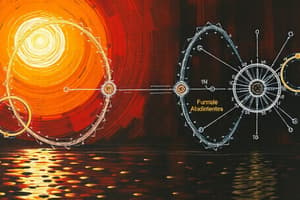Podcast
Questions and Answers
If an electron has the quantum numbers n = 3, l = 2, m sub l = 0, and m sub s = +1/2, which type of orbital does it occupy?
If an electron has the quantum numbers n = 3, l = 2, m sub l = 0, and m sub s = +1/2, which type of orbital does it occupy?
- 3f
- 3d (correct)
- 3p
- 3s
How many orbitals are present in the n = 4 energy level?
How many orbitals are present in the n = 4 energy level?
- 9
- 25 (correct)
- 16
- 32
Which of the following statements about the spin quantum number (m sub s) is correct?
Which of the following statements about the spin quantum number (m sub s) is correct?
- It determines the orbital shape.
- It differentiates between electrons in the same orbital. (correct)
- It is always positive for all electrons.
- It can take any integer value.
According to Hund's rule, which of the following electron configurations is correct for the 2p orbitals?
According to Hund's rule, which of the following electron configurations is correct for the 2p orbitals?
If an atom has the electron configuration 1s^2 2s^2 2p^6 3s^2 3p^5, what is the value of the angular momentum quantum number (l) for the last electron?
If an atom has the electron configuration 1s^2 2s^2 2p^6 3s^2 3p^5, what is the value of the angular momentum quantum number (l) for the last electron?
Which of the following statements about the Aufbau principle is correct?
Which of the following statements about the Aufbau principle is correct?
If an atom has the electron configuration 1s^2 2s^2 2p^6 3s^2 3p^3, what is the maximum number of unpaired electrons according to Hund's rule?
If an atom has the electron configuration 1s^2 2s^2 2p^6 3s^2 3p^3, what is the maximum number of unpaired electrons according to Hund's rule?
Flashcards are hidden until you start studying
Study Notes
- Electrons in an atom are arranged using 4 quantum numbers that describe atomic orbitals: principal quantum number (n), angular momentum quantum number (l), magnetic quantum number (m sub l), and spin quantum number (m sub s).
- The principal quantum number (n) represents the energy level of the electron, with larger values indicating orbitals further away from the nucleus.
- The angular momentum quantum number (l) ranges from 0 to n-1 and determines the shape of the orbital (s, p, d, f).
- The magnetic quantum number (m sub l) ranges from -l to l and specifies the number of orbitals of a type per energy level.
- The spin quantum number (m sub s) is always either 1/2 or -1/2 and helps differentiate between electrons in the same orbital.
- The Aufbau principle guides the filling order of orbitals in atoms based on their energy levels, leading to unique electron configurations for each element.
- Hund's rule states that for electrons with the same energy, one electron is placed in each orbital before doubling up.
- Understanding quantum numbers helps determine the electron configuration of atoms, which is crucial in chemistry for predicting chemical behavior.
Studying That Suits You
Use AI to generate personalized quizzes and flashcards to suit your learning preferences.




